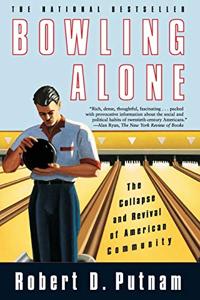
Want to learn the ideas in Bowling Alone better than ever? Read the world’s #1 book summary of Bowling Alone by Robert D. Putnam here.
Read a brief 1-Page Summary or watch video summaries curated by our expert team. Note: this book guide is not affiliated with or endorsed by the publisher or author, and we always encourage you to purchase and read the full book.
Video Summaries of Bowling Alone
We’ve scoured the Internet for the very best videos on Bowling Alone, from high-quality videos summaries to interviews or commentary by Robert D. Putnam.
1-Page Summary of Bowling Alone
Community involvement ebbs and flows throughout US history.
Putnam, a Harvard professor and member of the National Academy of Sciences, begins by describing the 1950s and 1960s as a time when Americans were more involved in their communities. Afterward, he reports that participation in clubs began to decline while trust in politicians declined as well.
Putnam argues that the lack of social involvement is bad for an individual’s economic, health, and happiness. It also affects society in general by reducing charitable institutions and volunteer fire departments. People are less likely to help each other out when they don’t trust one another or have a weak sense of community.
Overall, participation in all forms of political life dropped more than 30% between the mid-1970s and mid-1990s.
Political participation has fallen in the last few decades. Putnam blames this on a lack of social capital, which is generated by civic participation and trust. He says that baby boomers and gen Xers are less active than their parents were. Americans have lost faith in government after Vietnam and Watergate scandals, as well as the recent Enron scandal. People who spend time attending meetings or serving on boards or committees are more likely to be involved with civic activities such as voting, supporting political parties, signing petitions, following current events, attending school meetings and running for public office.
Fewer Americans participate in church activities, depriving society of its once greatest source of positive social capital.
The author believes that religious groups have traditionally played a major role in American society. They contribute more social good than other institutions and are very important for community life. The author states that though Americans’ belief in religion has not declined, their participation in religious activities like attending sermons and volunteering has declined significantly among Jews, Catholics, and Protestants over the past decades. Charitable giving is also down. However, there is an increase of Christian evangelism which tends to look inward rather than outward at others who need help from churches or charities; this amounts to a “hollowing out” of religious life in America according to the author’s analysis.
American social capital hasn’t shifted to the workplace.
Putnam analyzes the decline in civic and religious participation, which he attributes to water cooler conversations at work. He also discusses professional associations as a replacement for declining membership in civic or religious organizations. However, professional associations have declined dramatically compared with growth in the professions they represent. Water cooler conversations don’t replace community involvement; rather, they are just one aspect of socialization that takes place at work.
With the rise of remote work and contingent workers, people are more isolated than ever. They have fewer friends at work, which is why they’re less satisfied with their jobs. Moreover, there’s a growing number of Americans who don’t have a job or any benefits from it.
Informal socializing like entertaining neighbors and eating dinner with family has dropped precipitously since the 1970s.
Putnam states that there is a decline in socializing. He says people have fewer friends over for dinner, engage less often in team sports and rarely eat together as a family. This applies to Americans of all ages, races, income levels and locations. The only activity that has not declined is bowling but the number of teams has decreased greatly.






